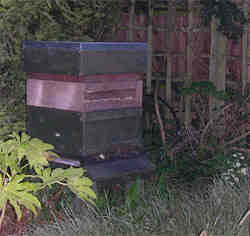Our colony of bees is behaving strangely
Posted by Fiona Nevile in Bees | 2 comments
Bees clustering around the hive entrance at dusk
However, there were always moments of apprehension when approaching the hive. There are just so many bees. Yesterday we realised that we had crossed a bridge. There was so much going on in the hive we just didn’t have time to be worried.
We donned our bee suits and went through the hive, searching for the queen. She can be hard to spot, even when she is marked with a white or coloured dot.
A drone is larger than the smaller worker bee and the queen is larger than a drone. She has a longer body with a more pointed end.
The queen in our new colony is unmarked. When we examined the colony with our local Bee Inspector, Lindsay, no one found her. That was not surprising as it’s a very vibrant colony with more bees than most others at this time of year.
There are other things to look for if you can’t find the queen. The first step is to look for evidence that she is laying. Fresh eggs look like small snippets of cotton thread, barley 2 millimetres long, one in the base of each cell. As these fatten and mature they are easier to see.
As the queen lays every day, an active colony will have eggs and brood at various stages of development on the same frame. We saw eggs yesterday but not the queen.
‘Going through the hive’ means examining each frame. There are eleven frames in the brood box. Understandably, the bees are not enthusiastic. A hive is a dark place. Suddenly people in white suits have whipped off the roof and are rooting through the colony. The bees get more and more agitated the longer it takes. Pros can whiz through a hive in ten minutes. Beginners can take half an hour to do the same job.
The brood box (egg laying area at the bottom of a hive) seemed pretty congested. Heavily congested brood boxes are liable to swarm. Signs that the bees are planning to swarm include the construction of queen cells. This indicates that the bees intend to breed another queen, which would lead to the old queen leaving with half the colony to find a new home.
Queen cells are bigger than a normal worker or drone cell so even I can spot them. We found five and removed these to deter the onset of a second queen being bred.
We also decided to put on another super (honey storage area) to distract the bees and give them more space. Hundreds of bees will be employed drawing out the foundation into comb and sorting out the frames that contain honey.
When we finally put the hive back together and put the roof back the bees acted strangely until well after dusk, hovering outside and clustering at the entrance
When we returned to the house we realised that we had made a mistake. A new super needs to be just over the brood box. We had put it on top of the existing single super that is already full of honey. The bees have no incentive to climb up beyond their familiar territory.
Tomorrow we plan to swap the supers over, placing the familiar full one at the top of the hive with the new half-empty one in the middle, just above the brood chamber. Hopefully this will settle the bees.
Meanwhile I have ordered few additional bits and pieces that we need to finish a second full sized hive as we are planning to split the colony into two.
Leave a reply






Hi Tammy, These certainly are a strong colony. They are all over the garden buzzing away. I was quite concerned at first as the hive is about eight feet from our garden table but they are not a problem, as yet. One brushed my cheek as it shot off on a mission this afternoon. They just seem to be focussed on doing their work.
So interesting. I’ve become fascinated by bees.